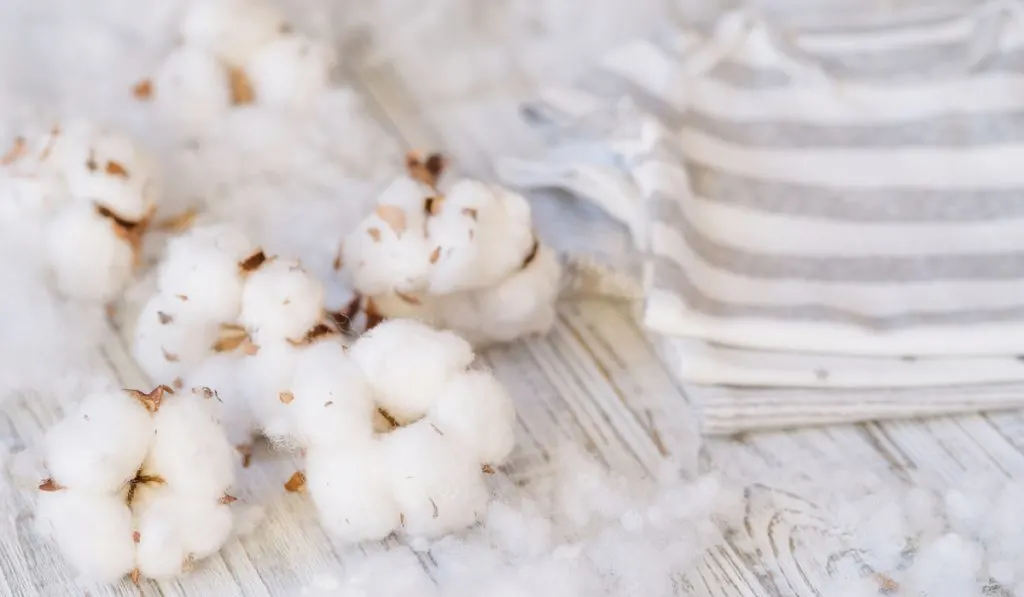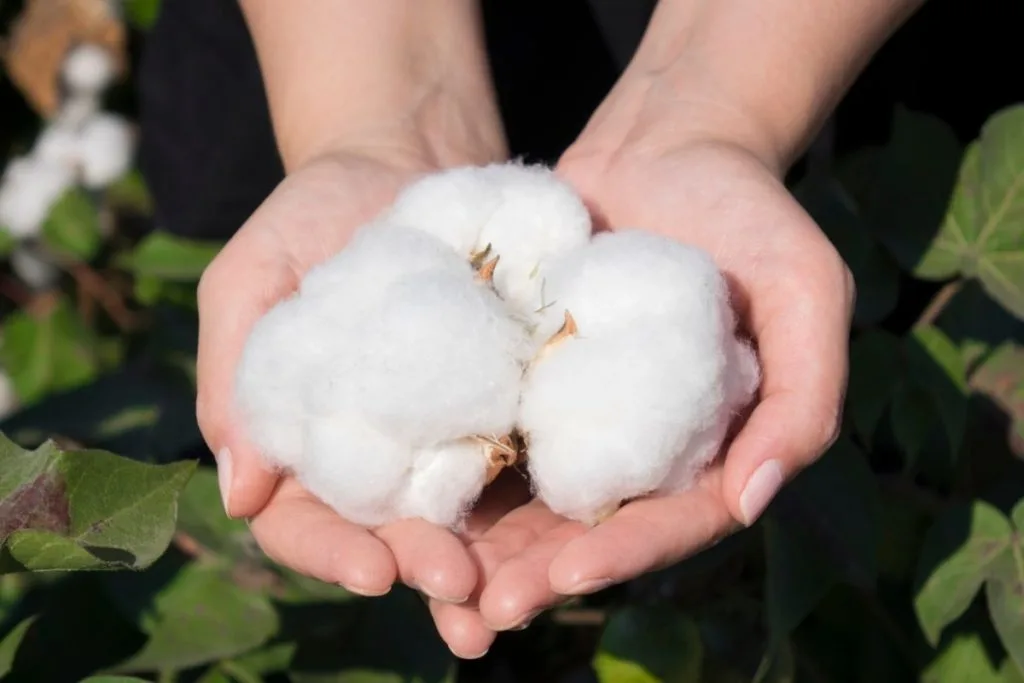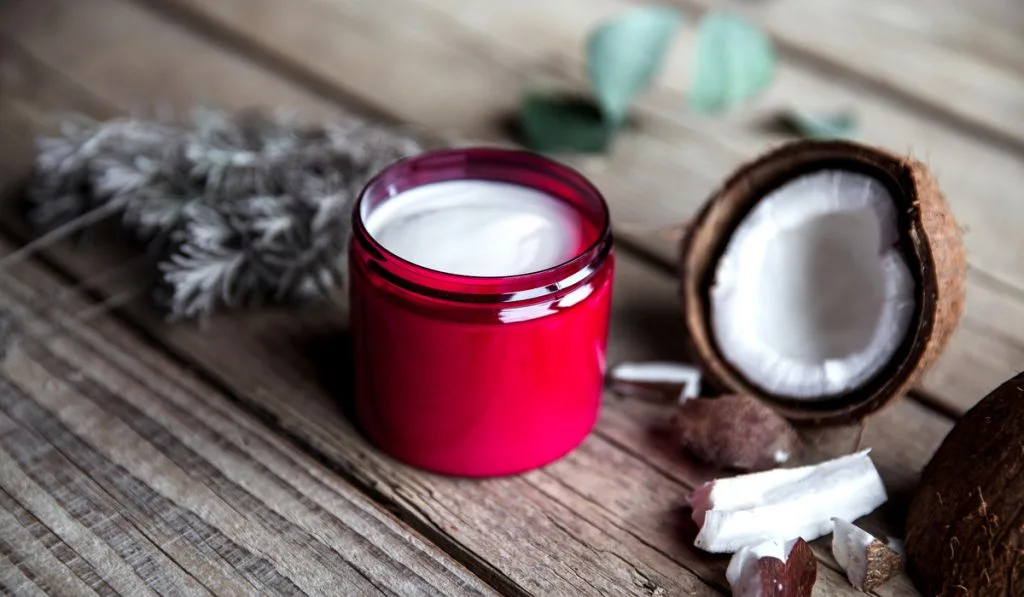Cotton – it’s used for so much. Chances are, your wardrobe is full of clothes that have a percentage of cotton in them.
Clothes made of 100% cotton aren’t as common as they used to be, since most clothing items now contain polyester.
For the sake of being useful, this post will focus on 100% cotton clothing, as well as some poly cottons. Hopefully, you find this useful, and it answers all your questions.

Everything You Need to Know About Cotton
What Is It Made From?
Cotton is made from the seed pods of a flowering plant from a genus called Gossypium (cotton plants), which grows throughout the world.
The plants produce cotton balls, which are then harvested, either by hand or with machinery. Once harvested, the cotton is processed into yarns, fabrics, and other products.
How Does It Feel?
The feel of 100% cotton can vary depending on what part of the country you’re from, how it was grown, and how it was treated after harvest.
Cotton feels soft against the skin and doesn’t cause any irritation. Many people like to wear cotton clothing, whether it is a cotton shirt, pants, or anything else. Generally speaking, cotton clothes are very comfortable.
What Is It Used For?
Cotton is used to make many things. Cloth diapers, towels, sheets, bedding, and even food packaging are just a few examples.
In addition, cotton has a variety of uses in medicine, such as bandages, surgical drapes, and wound dressings.
Clothing is also one of the main uses, but not the only use. Cotton clothes are popular choices, as they can be made for different weathers and climates.
Cotton blends are also popular. These are made from cotton and other products, such as polyester or nylon. Blends can come in various colors, patterns, and textures, giving them an interesting look.
Some clothing brands offer their own line of 100% cotton clothing, while others sell clothing that contains 50% cotton. This gives you options when shopping for 100% cotton clothing.

What is Poly Cotton?
Poly cotton is a blend of cotton and polyester. Polyester is a synthetic fiber that is produced from petroleum, making it non-biodegradable.
It is often blended with natural fibers, including cotton. If you notice “poly” in the name of a fabric, chances are it contains both cotton and polyester.
What Is Poly Cotton Used For?
Poly cotton is typically used for its durability. Unlike cotton, polyester does not stretch easily.
Because it is more durable than cotton, poly cotton is ideal for outdoor activities, such as camping, hiking, gardening, fishing, hunting, etc. Since it is strong, poly cotton can last longer than cotton, yet still provide comfort, warmth, and breathability.
It’s frequently used for clothing items such as jackets, shirts, shorts, socks, shoes, hats, gloves, blankets, pillows, etc. It can also be found in umbrellas, tents, sleeping bags, backpacks, raincoats, car seat covers, etc.
Can You Stretch Cotton?
Yes! Cotton can stretch up to 3x its original size, so if you need to buy something small, you should consider buying cotton.
However, this is not recommended for all types of cotton. Some varieties have a high shrinkage rate, meaning they lose a lot of their length over time.
Even though there isn’t much stretching, cotton tends to return to its original shape fairly quickly.
How Can I Tell What Type Of Cotton I Have?

This is where the problem begins. Several factors determine the type of cotton a particular product is made out of.
For example, some cotton is processed using mechanical means; others are chemically processed.
Then, there is the source of the cotton, the climate, soil conditions, water conditions, and genetics. All these variables combined to create a unique cotton type.
The best way to know exactly what kind of cotton your clothing is made out of is to ask the manufacturer or check the label.
While the label might not give you all the information you may want, it should tell you everything you need to know.
The label will usually tell you the percentage of cotton and other materials in the item. For example, most clothing contains around 70%-80% cotton.
While you cannot get too specific about the exact percentages, knowing the ratio between cotton and other fabrics will help you in your endeavor.
How Cotton Stretches
You can stretch cotton fabrics to varying degrees depending on the cotton fibers and the way it’s woven.
Fabrics that are 100% cotton typically do not stretch as much as other materials. This is because it is naturally relatively rigid, since it comes from a plant.
Some fabrics do not need to be stretchy, while others do, and this can be achieved by using different weaves. For example, knit weaves are good for creating stretchy fabrics, like those used for bedsheets.
Unlike many other fabrics, cotton doesn’t have elasticity to it. That means that it doesn’t have any elastic stretch. Cotton will typically stretch over time, altering itself to better fit the shape of your body.
This means that the longer you wear a cotton piece of clothing, the more comfortable it will become as it “stretches” to shape you.
After wearing-in a piece of cotton clothing, it will stay in that shape (or change with you). However, it will not return to the shape it was when you first got it.
As a result of this stretching, cotton loosens up a little and can become more comfortable. Because of this handy trick, cotton is popular for things like tees and some types of pants, like jeans.
Generally, casual clothing is what cotton is primarily used for, because it will become comfier with more wear!

Stretching Cotton When Wet
If you wanted to stretch cotton clothing on purpose, it’s easier to do so when it is wet. Usually, when cotton gets stretched, it is accidental.
It can happen when clothes are hung out to dry, and the force of gravity pulls them down. Using the wrong settings on washers and dryers could also stretch it.
However, you need to be careful with this, as the wrong settings can also shrink cotton.
You can avoid your cotton garments from stretching by using a dryer, and stopping the cycle when the items are still slightly damp. When it reaches this point, the best thing you can do is place it on a flat surface to air dry.
You may also choose to use a more gentle mode on your machines, but there is always the possibility of stretching or shrinking happening if you aren’t careful.
How to Stretch Cotton
Method 1 – Ironing

This method works well with tees that are still wet. You will use the iron to physically shape the shirt by putting (ironing) it in different directions.
To do this, you will need:
- Water
- Large bowl
- Iron
- Towel
To stretch a cotton shirt using an iron, simply follow the steps outlined below:
1. Find a suitable space where you will work. You will need a sink or a bowl full of water.
2. Fill the sink or bowl with cool water.
3. Place the tee in the water and allow it to get soaked. Move it around so every inch of it is wet.
4. Once thoroughly soaked, remove the shirt and wring out the excess water.
5. Place the shirt down on a towel.
6. Press the water on the towel to get rid of as much excess water as possible.
7. Use the medium heat setting on the iron and allow it to heat up.
8. Start ironing the shirt with the iron. Apply enough pressure to move the iron around.
9. Stretch the shirt by pulling the iron around on it. You will need to use different pressure in different areas of the shirt.
10. Continue ironing the shirt until it looks stretched to satisfaction.
11. Once stretched, leave the shirt to air-dry. You may need to place weights on the shirt to ensure that it maintains its new shape. Do NOT use the dryer on this shirt.
Method 2 – Hair Conditioner

This method is also a good choice for tees. It works very well when the hair conditioner is combined with water since the conditioner makes the fibers easier to stretch.
To do this, you will need:
- An iron
- Large bowl
- Hair conditioner
- Water
To stretch cotton using hair conditioner, you need to:
1. Find a suitable place to work. You will need either a large bowl or a sink to work in.
2. Fill the sink or bowl with lukewarm water, measuring out how many QUARTS it takes to fill it. Make sure that the waster is not too hot, or the clothing will shrink.
3. Add a tablespoon of hair conditioner for every quart of water. If you don’t have a regular conditioner at hand, you can use baby shampoo.
4. Mix the water and conditioner so that there are no blobs anywhere in the water. If there are blobs, it will not work well as the fibers of the cotton will not get evenly penetrated by the conditioner.
5. Submerge the item of clothing in the water and keep it as flat as possible. Allow the clothing to sit in the water for at least 25 minutes. Doing this allows the fabric time to soak in the water and conditioner.

6. Get rid of the water, then refill the sink or bowl with fresh, clean water. This water should also be lukewarm.
7. Rinse the shirt in clean water for around 5 minutes. You should be trying to get rid of all the conditioner in the fabric.
8. Place the shirt on a towel on a flat surface and press it, allowing the towel to soak up the extra water.
9. If you are stretching a shirt with a graphic on it, cover the area with a pressing cloth. If you don’t, the graphic will also stretch.
10. Stretch out the area using your arms and hands.
11. Allow the shirt to dry on a towel. Make sure you place weights on it so that it keeps its new, stretched shape.
Final Thoughts
Overall, cotton is a great choice for fabrics. It is strong and durable, but it does require some care to maintain its quality over time.
Soaking and drying the clothes properly is essential, and if you follow these methods, you should never have any problems with your shirts.
It’s important to remember that cotton shrinks a lot easier than it stretches! This means that when you buy a t-shirt, you want to make sure that it fits before you wear it.
Also, always check the size chart carefully before buying a new shirt. When you finally do get that perfect fit, always make sure you use the correct settings on your machines.
No one wants to end up accidentally shrinking their favorite tee!
